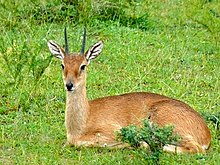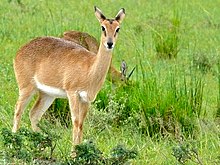Oribi
| Oribi | |
|---|---|

| |
| Male | |

| |
| Female both at the Murchison Falls National Park, Uganda | |
| Scientific classification | |
| Domain: | Eukaryota |
| Kingdom: | Animalia |
| Phylum: | Chordata |
| Class: | Mammalia |
| Order: | Artiodactyla |
| Family: | Bovidae |
| Subfamily: | Antilopinae |
| Genus: | Ourebia Laurillard, 1842 |
| Species: | O. ourebi
|
| Binomial name | |
| Ourebia ourebi Zimmermann, 1783
| |
| Subspecies | |
|
See text | |

| |
| Geographic range | |
| Synonyms[3] | |
|
List
| |
The oribi (/ˈɔːrəbi/; Ourebia ourebi) is a small antelope found in eastern, southern and western Africa. The sole member of its genus, it was described by the German zoologist Eberhard August Wilhelm von Zimmermann in 1783. While this is the only member in the genus Ourebia, eight subspecies are identified. The oribi reaches nearly 50–67 centimetres (20–26 in) at the shoulder and weighs 12–22 kilograms (26–49 lb). It possesses a slightly raised back, and long neck and limbs. The glossy, yellowish to rufous brown coat contrasts with the white chin, throat, underparts and rump. Only males possess horns; the thin, straight horns, 8–18 centimetres (3.1–7.1 in) long, are smooth at the tips and ringed at the base.
Typically
lasts for six to seven months, following which a single calf is born; births peak from November to December in southern Africa. Weaning takes place at four to five months.The oribi occurs in a variety of habitats – from
Taxonomy

The
In a revision of the
The following eight subspecies are identified:[1][8][9]
- O. o. dorcas Schwarz, 1914
- O. o. gallarum Blaine, 1913
- O. o. haggardi (IUCN.
- O. o. hastata (Peters, 1852) – Ranges from Kenya southward into Mozambique and eastward into Angola
- O. o. kenyae Meinhertzhagen, 1905 – Occurred on the lower slopes of Mount Kenya.
- O. o. montana (Cretzschmar, 1826) – Ranges from northern Nigeria eastward into Ethiopia and southward into Uganda.
- O. o. ourebi (Zambezi River.
- O. o. quadriscopa (C. H. Smith, 1827) – Occurs in western Africa
- O. o. rutila Blaine, 1922
Of these, zoologists Colin Groves and Peter Grubb identify O. o. hastata, O. o. montana, O. o. ourebi and O. o. quadriscopa as independent species in their 2011 publication Ungulate Taxonomy.[10]
Description
The oribi is a small, slender antelope; it reaches nearly 50–67 centimetres (20–26 in) at the shoulder and weighs 12–22 kilograms (26–49 lb). The head-and-body length is typically between 92 and 110 centimetres (36 and 43 in).
Only males possess horns; the thin, straight horns, 8–18 centimetres (3.1–7.1 in) long, are smooth at the tips and ringed at the base.[6][12] The maximum horn length, 19.1 centimetres (7.5 in), was recorded in 1998 from Malawi.[9] The oribi has at least six different, well-developed scent glands (such as the prominent preorbital glands near the eyes). The body has several modifications, such as the large fossae below the eyes, to accommodate such a large number of glands.[4] Females have four teats.[13]
Ecology and behaviour

The oribi is
Males defend their group's
Diet
Primarily a grazer, the oribi prefers fresh grasses and browses occasionally. Grasses can constitute up to 90% of the diet; preferred varieties include Andropogon, Eulalia, Hyparrhenia, Loudetia, Pennisetum and Themeda species. Mineral licks are also visited regularly. Oribi have been observed feeding on flowers and Boletus mushrooms. Groups of oribi congregate in the rainy season, when grasses are abundant.[4][11]
Reproduction
Both sexes become
Distribution and habitat
The oribi occurs in a variety of habitats – from
This antelope is highly sporadic in distribution; it occurs mainly in eastern, southern and western Africa, ranging from Nigeria and Senegal in the west to Ethiopia and Eritrea in the east and southward to Angola and the Eastern Cape (South Africa).[22] It is feared to be extinct in Burundi.[23]
Threats and conservation
The oribi has been classified as
The oribi occurs in a number of protected areas throughout its range, such as:
References
- ^ . Retrieved 19 November 2021.
- ^ "Oribia Kirby, 1899". www.gbif.org. Retrieved 1 June 2021.
- ^ OCLC 62265494.
- ^ ISBN 978-1-4081-2257-0.
- ^ "Oribi". Merriam-Webster.com Dictionary. Retrieved 24 April 2016.
- ^ a b c "Oribi Ourebia ourebi" (PDF). Endangered Wildlife Trust. Archived from the original (PDF) on 2016-06-02. Retrieved 2016-04-24.
- PMID 23485920.

- ^ "Ourebia ourebi". Integrated Taxonomic Information System. Retrieved 23 April 2016.
- ^ ISBN 978-1-107-39405-6.
- ^ ISBN 978-1-4214-0093-8.
- ^ ISBN 978-1-4729-2135-2.
- ^ ISBN 978-0-947430-55-9.
- ^ ISBN 978-0-643-09916-6.
- .
- .
- S2CID 53150077.
- S2CID 38863236.
- .
- S2CID 41424552.
- ISBN 978-0-226-43718-7.
- .
- ISBN 978-0-226-76032-2.
- ^ ISBN 978-2-8317-0477-7.
External links
 Media related to Ourebia ourebi at Wikimedia Commons
Media related to Ourebia ourebi at Wikimedia Commons Data related to Ourebia ourebi at Wikispecies
Data related to Ourebia ourebi at Wikispecies

